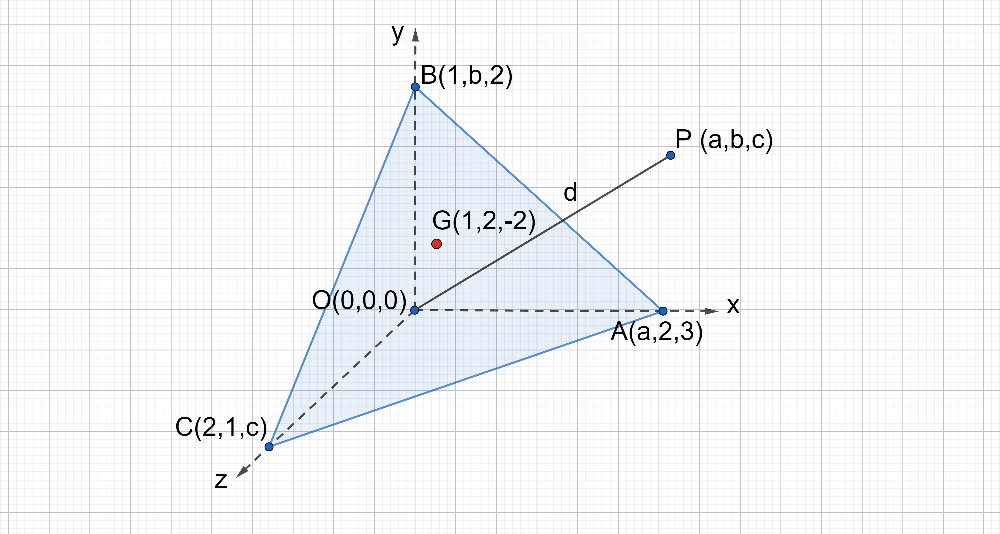
If the centroid of tetrahedron OABC where A, B, C are given by (a, 2, 3), (1, b, 2) and (2, 1, c) respectively is (1, 2, -2), then distance of P (a, b, c) from origin is
a) $\sqrt{195}$
b) $\sqrt{14}$
c) $\sqrt{\dfrac{107}{14}}$
d) $\sqrt{13}$
Answer
576k+ views
Hint: The centroid or geometric center of a figure is the arithmetic mean position of all the points in the figure. Let ABCD is a tetrahedron whose vertices \[\text{A(}{{\text{x}}_{1}}\text{,}{{\text{y}}_{1}}\text{,}{{\text{z}}_{1}}\text{); B(}{{\text{x}}_{2}}\text{,}{{\text{y}}_{2}}\text{,}{{\text{z}}_{2}}\text{); C(}{{\text{x}}_{3}}\text{,}{{\text{y}}_{3}}\text{,}{{\text{z}}_{3}}\text{)}\] and $\text{D(}{{\text{x}}_{4}}\text{,}{{\text{y}}_{4}}\text{,}{{\text{z}}_{4}}\text{)}$then, the centroid (G) is given as:
$G(x,y,z)=\left[ \dfrac{{{x}_{1}}+{{x}_{2}}+{{x}_{3}}+{{x}_{4}}}{4},\dfrac{{{y}_{1}}+{{y}_{2}}+{{y}_{3}}+{{y}_{4}}}{4},\dfrac{{{z}_{1}}+{{z}_{2}}+{{z}_{3}}+{{z}_{4}}}{4} \right]$. Use this formula to find the centroid for triangle OABC and then equate the coordinates with the point (1, 2, -2) to get the values of a, b and c. Now, we get point P (a, b, c). Then, find the distance between point origin and point P (a, b, c) using distance formula:
\[d=\sqrt{{{\left( {{x}_{2}}-{{x}_{1}} \right)}^{2}}+{{\left( {{y}_{2}}-{{y}_{1}} \right)}^{2}}+{{\left( {{z}_{2}}-{{z}_{1}} \right)}^{2}}}\]
Complete step by step answer:
Consider the diagram of tetrahedron OABC given below, whose vertices are $\text{A(a,2,3);B(1,b,2);C(2,1,c)}$ and $\text{O(0,0,0)}$.
G (1, 2, -2) represents the centroid of the tetrahedron, and P (a, b, c) is the arbitrary point at a distance ‘d’ from the origin.

For a tetrahedron with vertices, \[\text{A(}{{\text{x}}_{1}}\text{,}{{\text{y}}_{1}}\text{,}{{\text{z}}_{1}}\text{); B(}{{\text{x}}_{2}}\text{,}{{\text{y}}_{2}}\text{,}{{\text{z}}_{2}}\text{); C(}{{\text{x}}_{3}}\text{,}{{\text{y}}_{3}}\text{,}{{\text{z}}_{3}}\text{)}\] and $\text{D(}{{\text{x}}_{4}}\text{,}{{\text{y}}_{4}}\text{,}{{\text{z}}_{4}}\text{)}$, the centroid (G) is given as:
$G(x,y,z)=\left[ \dfrac{{{x}_{1}}+{{x}_{2}}+{{x}_{3}}+{{x}_{4}}}{4},\dfrac{{{y}_{1}}+{{y}_{2}}+{{y}_{3}}+{{y}_{4}}}{4},\dfrac{{{z}_{1}}+{{z}_{2}}+{{z}_{3}}+{{z}_{4}}}{4} \right]$
Therefore, for the given tetrahedron OABC whose vertices are $\text{A(a,2,3);B(1,b,2);C(2,1,c)}$ and $\text{O(0,0,0)}$, the centroid is
\[\text{G}(1,2,-2)=\left[ \dfrac{\text{a}+1+2+0}{4},\dfrac{2+\text{b}+1+0}{4},\dfrac{3+2+\text{c}+0}{4} \right]......(1)\]
By equating the coordinates of centroid in equation (1), we get:
\[\begin{align}
& \dfrac{3+a}{4}=1......(2) \\
& \dfrac{b+3}{4}=2......(3) \\
& \dfrac{5+c}{4}=-2.......(4) \\
\end{align}\]
So, we get values of a, b and c from equation (2), (3) and (4);
\[\begin{align}
& \Rightarrow a=1 \\
& \Rightarrow b=5 \\
& \Rightarrow c=-13 \\
\end{align}\]
Since the arbitrary point P is given as P (a, b, c). Substituting values of a, b, and c, we can write it as:
P (1, 5, -13)
Now, we need to find the distance between P (1, 5, -13) and origin O (0, 0, 0).
To find distance between two points \[\text{P(}{{\text{x}}_{1}}\text{,}{{\text{y}}_{1}}\text{,}{{\text{z}}_{1}}\text{) and Q(}{{\text{x}}_{2}}\text{,}{{\text{y}}_{2}}\text{,}{{\text{z}}_{2}}\text{)}\], use distance formula, i.e.
\[d=\sqrt{{{\left( {{x}_{2}}-{{x}_{1}} \right)}^{2}}+{{\left( {{y}_{2}}-{{y}_{1}} \right)}^{2}}+{{\left( {{z}_{2}}-{{z}_{1}} \right)}^{2}}}\]
Therefore, distance between P (1, 5, -13) and origin O (0, 0, 0) is:
\[\begin{align}
& d=\sqrt{{{\left( 1-0 \right)}^{2}}+{{\left( 5-0 \right)}^{2}}+{{\left( -13-0 \right)}^{2}}} \\
& =\sqrt{1+25+169} \\
& =\sqrt{195}
\end{align}\]
So, the correct answer is “Option A”.
Note: Another way to find centroid is stated below:
Firstly, find the centroids of each of the triangular faces of the tetrahedron. All the centroids when joined together form a triangle itself. Find the centroid of that triangle, which is the centroid of the tetrahedron. Equate the coordinates and get the values of a, b and c. Hence, find the distance between origin and P (a, b, c).
$G(x,y,z)=\left[ \dfrac{{{x}_{1}}+{{x}_{2}}+{{x}_{3}}+{{x}_{4}}}{4},\dfrac{{{y}_{1}}+{{y}_{2}}+{{y}_{3}}+{{y}_{4}}}{4},\dfrac{{{z}_{1}}+{{z}_{2}}+{{z}_{3}}+{{z}_{4}}}{4} \right]$. Use this formula to find the centroid for triangle OABC and then equate the coordinates with the point (1, 2, -2) to get the values of a, b and c. Now, we get point P (a, b, c). Then, find the distance between point origin and point P (a, b, c) using distance formula:
\[d=\sqrt{{{\left( {{x}_{2}}-{{x}_{1}} \right)}^{2}}+{{\left( {{y}_{2}}-{{y}_{1}} \right)}^{2}}+{{\left( {{z}_{2}}-{{z}_{1}} \right)}^{2}}}\]
Complete step by step answer:
Consider the diagram of tetrahedron OABC given below, whose vertices are $\text{A(a,2,3);B(1,b,2);C(2,1,c)}$ and $\text{O(0,0,0)}$.
G (1, 2, -2) represents the centroid of the tetrahedron, and P (a, b, c) is the arbitrary point at a distance ‘d’ from the origin.

For a tetrahedron with vertices, \[\text{A(}{{\text{x}}_{1}}\text{,}{{\text{y}}_{1}}\text{,}{{\text{z}}_{1}}\text{); B(}{{\text{x}}_{2}}\text{,}{{\text{y}}_{2}}\text{,}{{\text{z}}_{2}}\text{); C(}{{\text{x}}_{3}}\text{,}{{\text{y}}_{3}}\text{,}{{\text{z}}_{3}}\text{)}\] and $\text{D(}{{\text{x}}_{4}}\text{,}{{\text{y}}_{4}}\text{,}{{\text{z}}_{4}}\text{)}$, the centroid (G) is given as:
$G(x,y,z)=\left[ \dfrac{{{x}_{1}}+{{x}_{2}}+{{x}_{3}}+{{x}_{4}}}{4},\dfrac{{{y}_{1}}+{{y}_{2}}+{{y}_{3}}+{{y}_{4}}}{4},\dfrac{{{z}_{1}}+{{z}_{2}}+{{z}_{3}}+{{z}_{4}}}{4} \right]$
Therefore, for the given tetrahedron OABC whose vertices are $\text{A(a,2,3);B(1,b,2);C(2,1,c)}$ and $\text{O(0,0,0)}$, the centroid is
\[\text{G}(1,2,-2)=\left[ \dfrac{\text{a}+1+2+0}{4},\dfrac{2+\text{b}+1+0}{4},\dfrac{3+2+\text{c}+0}{4} \right]......(1)\]
By equating the coordinates of centroid in equation (1), we get:
\[\begin{align}
& \dfrac{3+a}{4}=1......(2) \\
& \dfrac{b+3}{4}=2......(3) \\
& \dfrac{5+c}{4}=-2.......(4) \\
\end{align}\]
So, we get values of a, b and c from equation (2), (3) and (4);
\[\begin{align}
& \Rightarrow a=1 \\
& \Rightarrow b=5 \\
& \Rightarrow c=-13 \\
\end{align}\]
Since the arbitrary point P is given as P (a, b, c). Substituting values of a, b, and c, we can write it as:
P (1, 5, -13)
Now, we need to find the distance between P (1, 5, -13) and origin O (0, 0, 0).
To find distance between two points \[\text{P(}{{\text{x}}_{1}}\text{,}{{\text{y}}_{1}}\text{,}{{\text{z}}_{1}}\text{) and Q(}{{\text{x}}_{2}}\text{,}{{\text{y}}_{2}}\text{,}{{\text{z}}_{2}}\text{)}\], use distance formula, i.e.
\[d=\sqrt{{{\left( {{x}_{2}}-{{x}_{1}} \right)}^{2}}+{{\left( {{y}_{2}}-{{y}_{1}} \right)}^{2}}+{{\left( {{z}_{2}}-{{z}_{1}} \right)}^{2}}}\]
Therefore, distance between P (1, 5, -13) and origin O (0, 0, 0) is:
\[\begin{align}
& d=\sqrt{{{\left( 1-0 \right)}^{2}}+{{\left( 5-0 \right)}^{2}}+{{\left( -13-0 \right)}^{2}}} \\
& =\sqrt{1+25+169} \\
& =\sqrt{195}
\end{align}\]
So, the correct answer is “Option A”.
Note: Another way to find centroid is stated below:
Firstly, find the centroids of each of the triangular faces of the tetrahedron. All the centroids when joined together form a triangle itself. Find the centroid of that triangle, which is the centroid of the tetrahedron. Equate the coordinates and get the values of a, b and c. Hence, find the distance between origin and P (a, b, c).
Recently Updated Pages
A man running at a speed 5 ms is viewed in the side class 12 physics CBSE

The number of solutions in x in 02pi for which sqrt class 12 maths CBSE

State and explain Hardy Weinbergs Principle class 12 biology CBSE

Write any two methods of preparation of phenol Give class 12 chemistry CBSE

Which of the following statements is wrong a Amnion class 12 biology CBSE

Differentiate between action potential and resting class 12 biology CBSE

Trending doubts
What are the major means of transport Explain each class 12 social science CBSE

Which are the Top 10 Largest Countries of the World?

Draw a labelled sketch of the human eye class 12 physics CBSE

How much time does it take to bleed after eating p class 12 biology CBSE

Explain sex determination in humans with line diag class 12 biology CBSE

Explain sex determination in humans with the help of class 12 biology CBSE




